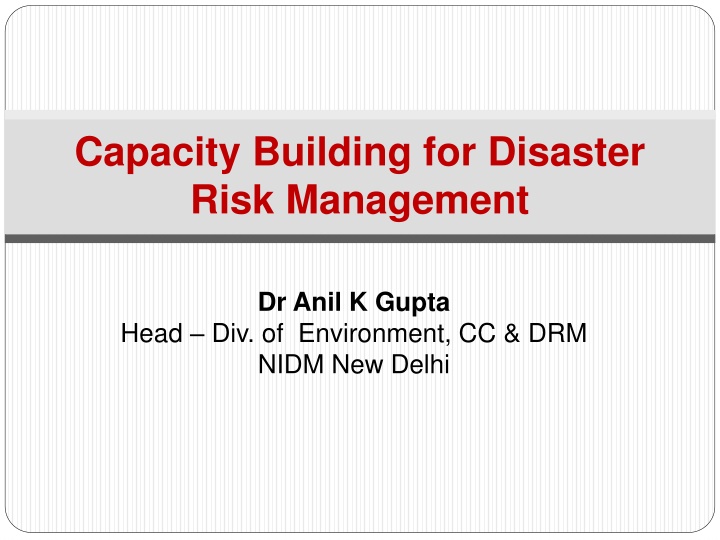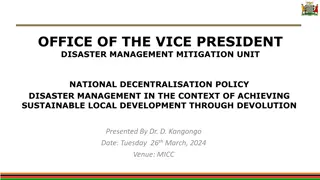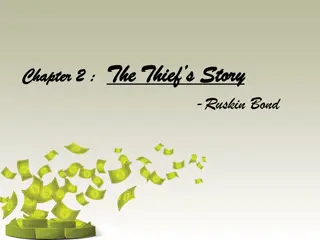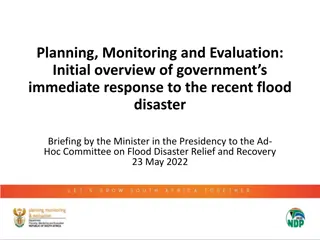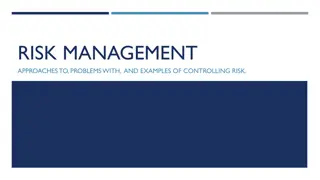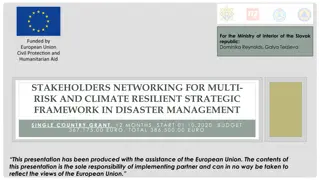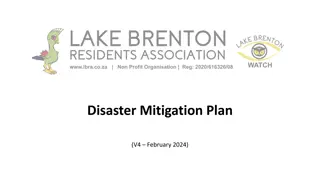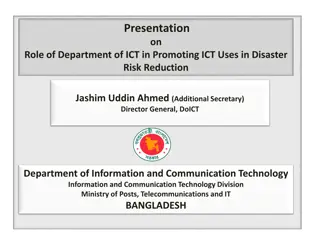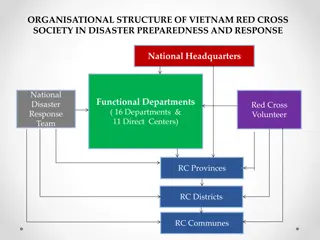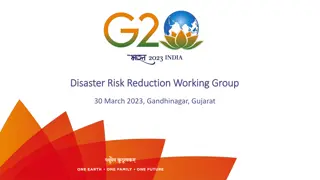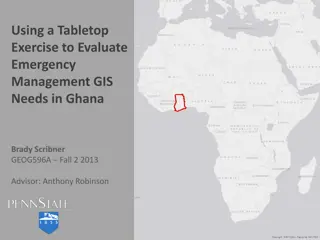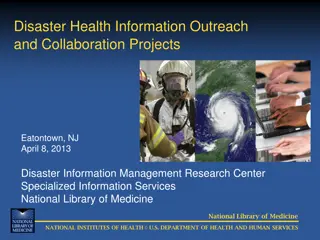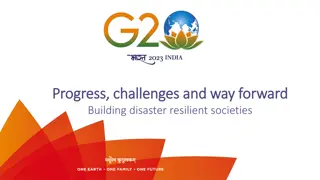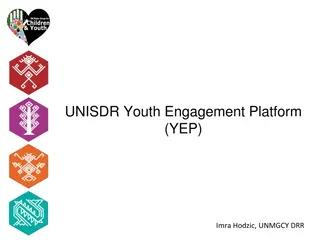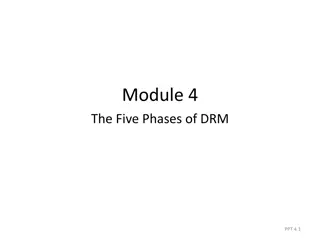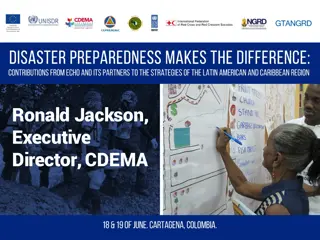Capacity Building for Disaster Risk Management - Dr. Anil K. Gupta
Disaster risk management paradigm shifting towards mitigation and preparedness, focusing on multi-hazard vulnerability assessment, environmental changes, and post-disaster assessments. Key challenges include mainstreaming disaster management plans and valuing non-economic impacts. New policy paradigms like the Sendai Framework and understanding disaster risk with evidence-based assessments are highlighted. The relationship between environment, climate change, and disasters is explored, emphasizing the role of environmental management in reducing vulnerability. Emerging issues include environmental changes as a risk driver and vulnerabilities influenced by environmental, technological, and behavioral factors.
Download Presentation

Please find below an Image/Link to download the presentation.
The content on the website is provided AS IS for your information and personal use only. It may not be sold, licensed, or shared on other websites without obtaining consent from the author.If you encounter any issues during the download, it is possible that the publisher has removed the file from their server.
You are allowed to download the files provided on this website for personal or commercial use, subject to the condition that they are used lawfully. All files are the property of their respective owners.
The content on the website is provided AS IS for your information and personal use only. It may not be sold, licensed, or shared on other websites without obtaining consent from the author.
E N D
Presentation Transcript
Capacity Building for Disaster Risk Management Dr Anil K Gupta Head Div. of Environment, CC & DRM NIDM New Delhi
Disaster Management Paradigm shift from Response & Relief to Mitigation and Preparedness Centric Loss of Life Reduced substantially but economic & other non-economic losses and damages continue to increase Legal and institutional mechanisms for disaster Management, Plans and Programmes
Key Challenges Multi - Hazard Vulnerability Assessment at District / Sub-district levels Understanding of changing risk scenarios with anthropogenic/developmental and environmental changes vis a vis climatic uncertainities Disaster Management Plans/Strategies Mainstreaming at Sectoral levels (within Government, Business and Community) Scientific and Systematic Approach to Post-disaster Assessments Valuation of Non-economic impacts, i.e. environmental, systematic & social impacts of disasters
New Policy Paradigm Sendai Framework for Disaster Risk Reduction (2015-30) Paris Climate Agreement (2015-30) Sustainable Development Goals (2015-30) Transition from Hyogo Framework to SFDRR Priority 4 of HFA (i.e. Addressing Underlying Factors of Risk) became Priority 1 in SFDRR Understanding Disaster Risk Evidence Based and Indicator Based Assessments
Environment, Climate & Disasters Stockhom 1972 Climate change aggravates hazards Rio Summit 1992 CC increases vulnerability (land, people, infrastructure) WSSD 2002 (Rio+10) UNFCCC (UNEP+WMO) Threefold relations: 4thAR (2007) Environmental changes as driver of disaster risk SREX Report 2012 (Asia) Paris Climate Agreement 2015 Disasters cause damage / losses to environment (which further aggravate disaster risk) 1.5 Degree Report (2018) Environment management reduce disaster risk & vulnerability 4x4 Assessment Report (India)
Emerging Issues Environmental change as risk driver - (i) climate change, (ii) land-use & landscape, (iii) natural resource degradation Vulnerabilities governed by (i) environmental (ii) technological and (iii) behavioural factors Addressing underlying causes of vulnerability (HFA Priority 4) Understanding Disaster Risk (SFDRR Priority 1)
The 2ndParadigm Shift Disaster Management (DM) was relief centric before 1991 IDNDR 1991-99 (Focused on Natural Disasters no attention on underlying causes) New Paradigm since HFA 2005-15 (Priority 4) Approach of inter-linking CCA DRR Climate Resilience - central to DRR Ecosystem Landscapes & Disasters Pathways & Tools of Mainstreaming DRR Turning point .Sendai Framework 2015-30 (Priority 1)
Paradigm Shift in Disaster Management Response Centric Relief Centric From Relief to Risk Reduction From Compartmental to Integration Mitigation centric Preparedness centric Disaster Centric From Ad-hoc to Organized From Single hazard to multi-hazard Hazard Centric Vulnerability Centric Environment Centric Climate Change Adaptation 2nd Paradigm shift
Approaches Previously .Response & Relief Centric
SFDRR highlights Four Priorities 1. Understand disaster risk 2. Strengthen disaster risk governance 3. Invest in DRR 4. Enhance disaster preparedness Resilience Ecosystem Based Solutions Integrating CCA Public Health Specific goals for DRR Monitoring Emphasis on Recovery
Operational Needs Translating CCA DRR Convergence to National / sub- national and local DRR /Development frameworks Disaster Risk Management Plans National /state, local, sector specific, department specific, etc.
Strategies for Mainstreaming: Pathways & Tools (Projects) Blended Approach (Addressing Knowledge & Capacity Gaps) Case Studies / Research Policies, Plans & Advocacy Training Manual / Modules Knowledge Based Volumes Upcoming Projects 03.
Initiatives/Projects Climate Resilient Development & Adaptation 2006- 07 (UNDP/MoEF) Rajasthan, UP, Gujarat. Urban Flood Case Studies (8 Cities) 2007-08 UF. National Action Plan on Chemical Disasters 2010 MOEF. Risk to Resilience 2010: Strategic tools for DRM. DFID, US-NOAA, ISET, WII, RF, GEAG, IIASA. Climate Sensitive DM Planning Flood Resilient Uttar Pradesh (CDKN-UK / ISET) 2012-13. Drought Vulnerability - Risk & Mitigation Analysis 2011-13 (ICSSR Funded )
Indo-German ekDRM Programme: Environmental Knowledge for DRM 2011-13. MoEF / GIZ / UNU. AdaptCAP- DRR Coastal (AP & TN) EU & GIZ 2014 Ecosystem Approach to DRR (UN-PEDRR) / UNEP ecoDRR National Human Resource Plan for DRM (2011-12) as per DM Act 2005. HRP National Disaster Management Plan (2013 for NEC on DM Govt. of India), NDMP Released 2016. Perspective Plan of NIDM s Expansion & Strengthening 2014. PP Prime Minister s Agenda 10: DM Plan of Sectors / Ministries at Central Level. PM10
India Heat Wave Study 2015-16. Integrating Climate Resilience into DRR (Knowledge & Training) Govt. of Maharashtra: Case Study Compendium Establishment of ecoDRR Centre under Forest Academy, Govt. of Maharashtra (DPR) Forest Fire ..FFMP Peri-urban Ecosystems for Urban Resilience (RF) Climate Change and Vulnerability of Children (UNICEF) Policy Volume on Climate Change and Disaster Risk Management (MoEFCC Sponsored). Climate Resilient Development Planning (NKMCC)
Disaster Management Plan of Agriculture Sector (MOAGFW). Disaster Impact Assessment (DIA) Integration with EIA/Project Appraisal. UNU, PwC) Climate Change Adaptation Plan for Health Disaster Related Illness. (WHO/NCDC) Other documentations/Books.
Road Ahead Huge gaps in capacities (Knowledge & Professional Competence) Demonstrable Solutions / Pilots / Case Studies (Showcasing) Institutional network (Consortium framework) Collaborative programmes with Partner Institutions Research and Innovations Bridge between Science Institutions, Implementers and Policy Process. Publications of lessons and outcomes.
Thank You! For all support, motivation and encouragements !!! https://www.researchgate.net/profile/Anil_Gupta15
